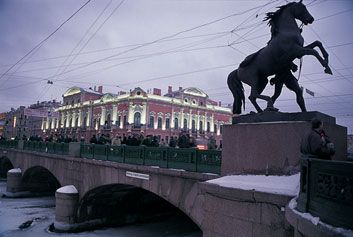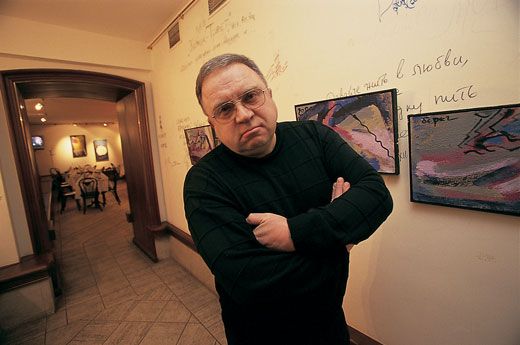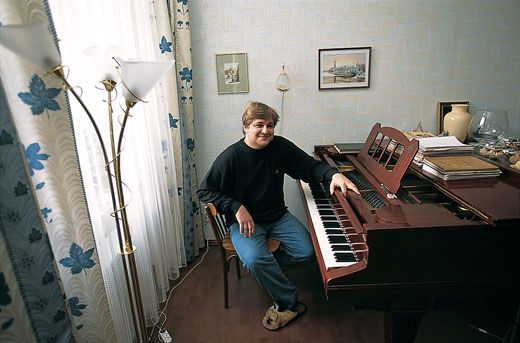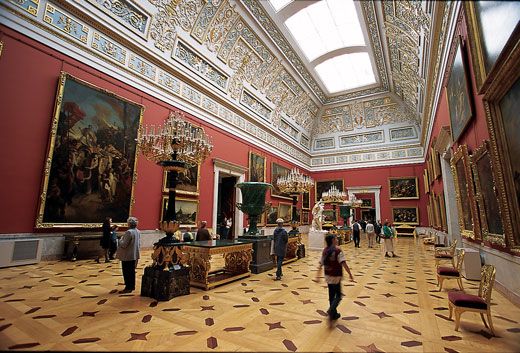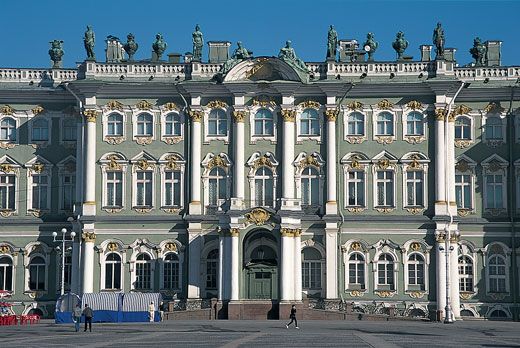Russia’s Treasure-House
Searching for the past on the eve of St. Petersburg’s 300th anniversary, a former foreign correspondent finds the future
Nevsky prospekt, St. Petersburg’s main thoroughfare, radiates out from a landmark of neoclassical architecture that once housed the headquarters of the Russian Navy. It was here at the Admiralty, where the swift, gray waters of the NevaRiver rush toward the Baltic Sea, that Peter the Great fulfilled the primary purpose of the city he founded in 1703: building the fleet that made Russia a fearsome maritime power. He crowned his shipyard with a soaring spire, like the needle of a compass.
As a foreign correspondent based in Moscow from 1982 to 1985, I traveled often to St. Petersburg. (It was called Leningrad from 1924 until 1991.) Each time I have returned over the past 20 years, I have gone first to the Admiralty’s spire, walking a mile or two along Nevsky Prospekt to get my bearings. I traced that route again recently as the city prepared for its 300th anniversary celebration this month.
Along the boulevards of many cities, the new is immediately obvious: glass-and-steel skyscrapers impose themselves on the horizon. But on Nevsky Prospekt the low profile has remained much the same for centuries. The tallest buildings rise only five and six stories, mainly because the marshy ground beneath the city will not support high-rises, but also because the State Inspectorate for the Preservation of Monuments prohibits them.
About a half mile down the 2.8-mile avenue, Kazan Cathedral, completed in 1811, still boasts 364 feet of curving neoclassical colonnade; ornate 19th-century bridges arch over canals flowing under the thoroughfare. Gostinny Dvor (Merchants’ Lodging), the yard where caravan traders hawked their wares in the 18th century, remains the city’s shopping hub. Of course some things have changed since my trench coat days. During the Communist era, the Kazan Cathedral housed a museum of atheism, and shops in Gostinny Dvor scorned Western goods as icons of decadence. Today the Kazan Cathedral once again is the site of Orthodox services, and the stores stock American jeans and French perfumes.
Elsewhere during my visit, much of the city was shrouded in scaffolding as workers painted and plastered, preparing for the concerts, parades, regattas and outdoor theater that will mark commencement of the city’s tercentennial. (In various American cities, too, including Washington, D.C., Baltimore, Maryland, and New York City, international consortiums have mounted exhibitions that celebrate St. Petersburg’s anniversary.) Laborers were even replacing worn cobblestones in Palace Square, where the Bolsheviks stormed to power in October 1917.
Today’s St. Petersburg is neither the city those revolutionaries seized nor the one they left in decay in 1990. On lower Nevskiy Prospekt, a coffeehouse outlet, the Ideal Cup, aspires to become Russia’s equivalent of Starbucks. New restaurants, too, have blossomed: at Propaganda, colorful posters urging the proletariat to work harder lampoon Soviet-era exhortations. Nearby, a vegetarian café, the Green Cross, seems impossibly exotic in a country where, not so very long ago, a major indicator of prosperity was the right to buy meat without a ration coupon.
The city remains a monument to Peter the Great. On May 27, 1703, soldiers of the czar spaded up the first clod of soil on an island in the Neva, a place Peter would ordain the capital of all Russia, named after his patron saint. The site was a bog—frozen nearly half the year—when he wrested it from Sweden. He decreed that thousands of peasants be pressed into forced labor; they built St. Petersburg by hand, driving 16-foot-long oaken piles into marshes, dragging stones, digging canals. Disease was rampant. Thousands of workers died—estimates range up to 100,000. It was, they said, “a city built on bones.”
Peter envisioned a great urban showcase, a Russian window on the West. By 1715 or so, European architects and painters, dancers, musicians and craftsmen had converged here to create an urban center neither wholly Western nor traditionally Russian. They left monuments: palace after palace, including the grandest of them all, the 18th-century Baroque masterpiece known as the Winter Palace, destined to house the Hermitage Museum; churches that range from massive domed landmarks to fanciful confections festooned in candy-cane stripes; temples of culture, like the pistachio-green Mariinsky Theater, home of the Kirov Ballet. In those splendid buildings, St. Petersburg’s artists created literature and music that endured long after Peter’s dynasty fell to revolution in 1917: the poetry of Pushkin; the novels of Dostoyevsky and Gogol; the music of Mussorgsky, Rimsky-Korsakov and Tchaikovsky.
At the hermitage, director Mikhail Piotrovsky, 59, a fifth-generation St. Petersburger, presides over one of the world’s great repositories of art. His late father, Boris, was also director there, from 1964 to 1990. During World War II, as a young man, Boris helped protect the museum from Nazi bombardment. The German Army laid siege to Leningrad from September 1941 until January 1944. Hundreds of thousands of inhabitants starved to death. Yet the city did not surrender. “My father,” says Piotrovsky, “served in those years as the Hermitage’s deputy fire director. During the freezing nights, he stood guard on the building’s roof, ready to extinguish fires caused by the bombing.” (Miraculously, the museum survived, despite hits from 32 artillery shells and two bombs.)
Today, Piotrovsky confronts a less desperate, but nevertheless urgent, imperative: fund-raising. Under his leadership, the museum brings in roughly half its annual budget from private sources (the other half comes from the state). Urbane and gray-haired, he works at a desk beneath a portrait of Catherine the Great, who, between 1762 and 1796, developed the museum’s collection. (She stored her purchases in a more intimate auxiliary palace next door, which she called her hermitage, or retreat. The name now embraces the entire complex.)
When the Soviet Union collapsed, Piotrovsky says, much of the city’s economy, based primarily on defense factories, collapsed as well. Scheduled state subsidies failed to arrive. The Hermitage struggled. “The fact that the city survived and is now in a position of a little more stability is, in large part, thanks to its cultural institutions.” Once a city of power, St. Petersburg has now become a city of art.
In a cramped basement not far from Arts Square—a complex that includes the St. Petersburg Philharmonia and the RussianMuseum—St. Petersburg’s transition to capitalism can be seen in an unlikely venue. From 1912 to 1915, the cellar housed the Stray Dog Café, which played a role in Russian literary life not unlike that of the Algonquin Round Table in American letters.
Night after night, the legendary poet Anna Akhmatova sat in a corner there surrounded by admirers, smoking cigarettes and drinking coffee as black as the slinky dresses she wore to recite her verse.
Through the harrowing years of World War I, Akhmatova came to personify St. Petersburg’s endurance. One by one, her loved ones, victims of war or of the Russian Revolution, were killed or sent to the Siberian gulag. Through it all she continued to write. Sometimes, rather than risk setting a poem on paper, she committed it to memory, reciting fragments to a few trusted friends, who memorized their stanzas, waiting for the day when it would be safe to reassemble and publish the verse.
Among the poems Akhmatova, who died in 1966, left behind is one about the Stray Dog Café:
We’re all boozers and strumpets here,
How gloomy our company.
On the wall the birds and flowers
Are longing to see the sky. . .
Oh what pain my heart is lancing.
Will it soon be my death hour’s knell?
The one over there who’s dancing
Will certainly go to hell.
By the time of the Russian Revolution, the café had disappeared except in the memory of Leningrad intellectuals. When glasnost came to Russia in 1986, Vladimir Sklyarsky, a theater director, descended into the old Stray Dog basement. “It was full of water and rats,” recalls his wife, Evgenia Aristova. “I thought it was Utopian to think about restoring it.”
The undaunted Sklyarsky, who was ill the day I visited, managed to enlist colleagues, along with arts students and preservationists, to his cause. He stripped the café’s walls to bare brick, and in a whitewashed passageway encouraged St. Petersburg artists to draw caricatures, scrawl autographs, write a line of verse. It took 15 years, but in 2001 the Stray Dog reopened.
Most nights now there’s a poetry reading, a one-man play or a musical performance. The night I was there, three actors staged a stark, biographical drama surveying the life of the poet Osip Mandelstam, a contemporary of Akhmatova’s who perished in Stalin’s camps. The little basement room was full of people, young and old, holding hands, sipping drinks, smoking furiously and applauding the performers.
But by 9:30 p.m., the café was largely empty. “Poetry lovers can’t afford to eat and drink enough,” Evgenia Aristova sighed. Sometimes, she added, they bring their own vodka in pocket flasks, rather than buy drinks at the bar.
Founded in 1738, the VaganovaBalletAcademy has occupied the same creamy white-and-gold complex of neoclassical buildings since 1836. In 1957, the academy, whose graduates include such dance giants as George Balanchine, Nijinsky, Mikhail Baryshnikov, Rudolf Nureyev and Anna Pavlova, was renamed in honor of Agrippina Vaganova, the legendary teacher who presided there from 1921 to 1951. In her memoirs, Pavlova described the school as a “convent whence frivolity is banned and merciless discipline reigns.”
“We have 300 pupils in the performing department,” Yulia Telepina, a 26-year-old staffer, tells me. “They enter when they are 9 or 10.” Medical examinations determine whether a child can endure the school’s regimen: six hours of dance classes and practice each day, six days a week, for eight years. Telepina estimates that for every successful applicant, nine are turned away. About 60 students are admitted each year. Eight years later, fewer than half graduate.
In a large rehearsal hall, 11 members of the senior girls’ ballet class begin their warm-up exercises at a bar extending along three walls. The teacher, Lyudmila Safronova, who herself began studies at the academy in 1938, enters dressed in a severe black ensemble. “Don’t move the arms so much,” she commands Alina Somova, a dark-haired 17-year-old in white tights, red leotard and running shorts. “It’s enough to move the hands.”
After class, Somova—like many artists I spoke to in St. Petersburg—acknowledges that she can’t make a living here. Upon graduation, she says, “I want to try my skills abroad.”
one afternoon, outside the Rimsky-Korsakov music conservatory, pianist Petr Laul picked me up in a battered white Mercedes that, at 21, was only three years younger than he. He skirted a narrow canal before turning onto a side street. “See the building on the corner?” he said, pointing to dingy brick apartments. “Dostoyevsky lived there when he wrote Crime and Punishment.”
We entered his apartment building via a dark, dank passage that seemed as if it had not been painted since Dostoyevsky’s time—a typical condition of most Russian apartment buildings. Laul, dressed in jeans and a beret, indicated a doorway opposite a courtyard: “Some people say that the garret Dostoyevsky had in mind for the character of Raskolnikov was at the top of the stairs beyond that door.”
Laul’s apartment is a third-floor walk-up. As soon as we stepped inside, he phoned the police and gave them his entry code. Because he owns three pianos, a computer and a large collection of CDs and phonograph records, he subscribes to an enhanced police security service.
In his kitchen, he made coffee and talked about his grandfather, Alexsandr Dolzhansky, who taught polyphony at the conservatory. Shortly after the end of World War II, Stalin’s postwar cultural purges began. In 1948, the party declared that the music of St. Petersburg composer Dmitry Shostakovich contained “formalist perversions.” Meetings were called to denounce him. Laul’s grandfather was expected to join in the ritual condemnation. “Instead, he stood up [at a faculty meeting] and said he considered Shostakovich a genius. He could have gone to jail. Thank God they only fired him from the conservatory.” Ten desperate years would pass before Dolzhansky was again permitted to teach.
Laul, who trained at the school where his grandfather and father taught for many years, won the prestigious Scriabin Competition in Moscow in 2000. In my day, this would have placed him in the hands of the Soviet state booking agency, Goskontsert, which dictated the performance schedules of Soviet musicians. But in the new order, Laul has a Germany-based agent who books appearances for him in that country. He has also performed in the United States, France and Holland and estimates he is one of perhaps ten concert pianists in St. Petersburg who can make a living at it. To do so, however, he must perform abroad.
Will he continue to live in the city? He shot me a look. “I can’t leave,” he said in a voice full of exasperation. “Abroad, life is comfortable and easy and pleasant, but it’s boring, like a sanatorium. Here it’s interesting—sometimes very unpleasant—but interesting.”
Here, he says, he senses ghosts, shades of the great St. Petersburg musicians, whenever he enters the conservatory, where Tchaikovsky’s name is etched on a wall as the outstanding graduate of 1865, where Jascha Heifetz studied violin and composer Rimsky-Korsakov taught. “It’s such a harmonious city,” he says. “If not for St. Petersburg, you wouldn’t have had Gogol, Pushkin, Mussorgsky, Tchaikovsky, Dostoyevsky.”
And St. Petersburg still inspires novelists to themes of crime and punishment. Across the street from the VaganovaAcademy, the Agency for Investigative Journalism is headed up by Andrei Bakonin, 39, a tall, athletic journalist with thick black hair and a brushy mustache. As it happens, in the mid-1990s both Bakonin and I wrote suspense novels set at the Hermitage. Each revolved around a forgery of one of the museum’s masterpieces; he chose a Rembrandt and I a Leonardo. In both books, villains plotted to sell the real paintings to collectors and pocket the proceeds. There was, however, one important difference: while my novel—Dispatch from a Cold Country—beat a hasty path to the remainder tables, his Defense Attorney, written under the name Andrei Konstantinov, was a minor sensation and a mega-seller.
When the USSR collapsed in 1991, Bakonin, who had worked as a translator in the Soviet Army, was discharged. The next year, he landed a job at a St. Petersburg newspaper, covering the crime beat. He branched into novels and also established the Agency for Investigative Journalism.
There, he and his colleagues have produced 27 books, nonfiction and fiction both—“17 or 18 million copies,” he says. “In America, I would probably be a very rich man. But not in Russia. Sell a million books and you make maybe $90,000. If you calculate for nine years, I’ve earned maybe $400,000. I spent most of it. I have a nice car by Russian standards, a Honda SUV, and a five-room apartment now being remodeled.”
Bakonin says he sometimes finds the Russian classics heavy going. “In the West, they take two authors very seriously—Tolstoy and Dostoyevsky, right? There’s even a term, ‘Tolstoyevsky.’ Tolstoy has absolutely no sense of humor. Of course, he’s a genius. But both he and Dostoyevsky have a problem with humor.”
Gennady Viunov is restoring the ornate wrought-iron fence that separates the gardens of the Mikhailovsky Palace, which houses the Russian Museum, from the Church on Spilled Blood. That Russian Revival church was built on the site where anarchists assassinated Czar Alexander II in 1881. Viunov, a husky, bearded man in his mid-40s, trained as a sculptor at the city’s Academy of Arts and worked in architectural restoration. Eight years ago, he and some colleagues founded a private firm specializing in forged iron. They have re-created the skills employed by St. Petersburg’s blacksmiths in the days of the Russian Empire.
“One of the great treasures of St. Petersburg is its forged metal,” he says, as we drive out of the city in his Soviet-era Volga sedan. “The great architects drew their own designs. If you have a palace or a park, it has a fence. Wrought iron is like a foil for a precious stone. It gives the city a museum quality.”
He can thank the Bolsheviks for the profusion of wrought iron here. When Germans, advancing on the Western Front in World War I, pushed perilously close to St. Petersburg in 1918, Lenin returned the Russian capital to Moscow. So it was in Moscow after the war that hundreds of buildings were torn down to make way for the bleak concrete hulks that housed the Soviet bureaucracy. The palaces and landmarks of St. Petersburg lay untouched. In many cases, they were also left to rust and rot, which is why there is much work for Viunov to do.
His plant is located in a series of low, grimy structures, once outposts of the Cold War. Just inside one building, Viunov points out renovated 12-foot-high segments of iron fence awaiting reinstallation in the city. No two are alike; they feature elaborate patterns of leaves and stylized sunflower blossoms. “There’s a lot of symbolism in this fence,” he says. “You can see the leaves drooping. It gives a sad impression. I think the architect was meditating on the death of the czar.”
Thus far, 19 of the fence’s 53 segments have been completed, he adds, at a cost of about $20,000 each, thanks to support from many donors, including the FabergéArts Foundation, a group based in St. Petersburg and Washington, D.C. that is dedicated to preserving the city’s heritage.
That legacy appears all the more remarkable when contrasted with much of the landscape lying beyond the central city: bleak and soulless blocks of Soviet-era apartment buildings, where many of St. Petersburg’s four million citizens live.
Dmitri Travin, 41, writes a business column for a St. Petersburg newspaper and lectures on economics at the EuropeanUniversity, a new graduate-level institution that gets the bulk of its funding from Western foundations. “St. Petersburg had a structural crisis after the Soviet collapse,” Travin says. “In the first half of the ’90s, there was a lot of hidden unemployment. People had jobs, but with no or very little pay.
“The economy here,” he goes on, “had already begun to grow in 1996. But the big change came in 1998, when the ruble was devalued by a factor of four. Imported goods became too expensive and disappeared. By that time, a lot of local enterprises were ready to replace foreign suppliers.”
Now, says Travin, the beginnings of Western class structure have begun to emerge here. “We have a small group of the very rich and a fairly big middle class, made up of skilled workers, branches of the intelligentsia, small businessmen.” But there is also a large impoverished class composed of the “old poor”—laborers and retirees who have no skills to sell in the new marketplace or who subsist on inadequate pensions—and of the “new poor,” who depend on a fixed state salary—everyone from bus drivers to teachers and researchers. “There are people with doctoral degrees trying to get by on $50 per month,” he says.
Like the Hermitage’s Piotrovsky, Travin believes the arts have helped save the city, which, he feels, has the potential to be a world cultural center. “Unfortunately, we do very little to market ourselves,” he says. “Around the world, Russia has the image of an unstable country.”
On my last night in St. Petersburg, I heard from an old friend, Valery Plotnikov, a photographer I knew in Moscow in the 1980s. Since then, he has moved back to St. Petersburg, his hometown. He stopped by my hotel, which, in itself, was a departure from our old habits. In the Communist era, we met on street corners, and I would escort him to my quarters under the suspicious gaze of policemen charged with discouraging contacts between Russians and foreigners.
Tonight, in the hotel café, we order shrimp and beer, catching up on old times. He has divorced and remarried and now has grandchildren. He also has a new apartment he wanted to show to me. We walked up Nevsky Prospekt in a chill rain, first turning from a side street to the building where he maintains a studio. Inside, he pulled from the shelf a recently published book of his photographs, spanning the 1970s to the late ’90s. Valery specializes in portraits of people in the arts—actors, writers, musicians. As I leafed through the pages, it struck me that the book could be seen as an elegy to the last generation of Russian artists to mature and work under Soviet power. Baryshnikov was there, looking very young. So were many others who had never gotten out of the country, never been permitted to flower.
We left the studio, walking through a courtyard to arrive at a new six-story apartment building with spacious terraces. “This is my new place,” Valery said with obvious pride. His apartment is on the top floor. In the foyer we remove our shoes. He shows me the bathroom, with its Jacuzzi-style tub; the big kitchen; the sleeping alcove; the large main room, still barely furnished. He turned on the stereo: Ella Fitzgerald, a mutual favorite. We stepped out onto his terrace.
The rain had let up, but the night air was still misty. Valery gestured across the street to an old building, its windows gaping. It was, presumably, a candidate for either renovation or demolition. It reminded me of the building his cramped Moscow flat was in. “You remember how in the Soviet days, all the reporting from America always called it ‘a land of contrasts’?” he asked me. “How they always showed there were poor people next to the normal people?” I nodded.“Well,” he said proudly, gesturing from his new building to the one across the street, “now we’re a land of contrasts!”
I smiled. The old “land of contrasts” theme had, of course, been little more than journalistic jargon, about as valid as any assertion I might make today that St. Petersburg has become a normal European city. A century of calamity and misrule cannot be overcome quickly, not even in a decade. But as we stood on the terrace of that new building, looking out over the city’s roofs, it seemed possible to believe that in its fourth century this stately, resilient city might finally become a place where its gifted, courageous people could lead the lives they deserve.
Planning Your Next Trip?
Explore great travel deals
Smithsonian magazine participates in affiliate link advertising programs. If you purchase an item through these links, we receive a commission.
